
Albin Reine Roussin (French pronunciation: [albɛ̃ʁɛnʁusɛ̃] ; 21 April 1781 – 21 February 1854) was a French admiral and statesman.

Albin Reine Roussin (French pronunciation: [albɛ̃ʁɛnʁusɛ̃] ; 21 April 1781 – 21 February 1854) was a French admiral and statesman.
His father was a lawyer who was arrested during the French Revolution when Roussin was aged twelve. He left home in Dijon and travelled to Dunkerque where he enlisted as a cadet in the French Navy in December 1793. He served from 1794 to 1797 on various frigates. In 1801 he sat and passed the midshipman's exam following to lessons from the hydrographer Jean Petit-Genet.
His first posting as an officer was to command a gunboat at Antwerp, part of the "National Flotilla" of coastal ships, collecting in various Channel ports for Napoleon's projected invasion of England. By 1803 he was promoted to ensign and embarked aboard the frigate Sémillante under the command of Captain Léonard-Bernard Motard. They would spend six years in the Indian Ocean, based on Réunion, preying on British shipping bound to and from India.
The worn-out Sémillante was paid off at Mauritius in 1808 after sustaining damage in a fight with the Royal Navy frigate Terpsichore. Roussin was promoted to lieutenant and posted to the corvette Iéna . A cruise in the Persian Gulf and the Bay of Bengal ended when the Iéna encountered the 46-gun Royal Navy frigate Modeste off Calcutta and was captured after a two-hour engagement on 8 October 1808. Roussin and his captain, Lieutenant Maurice, were exchanged at the end of 1809 and returned to Réunion. Roussin was appointed second in command to Bouvet de Maisonneuve aboard the frigate Minerve, a prize taken by Guy-Victor Duperré. Roussin received a mention in Bouvet's dispatches for his conduct during the battle of Grand Port in August 1810. However, the French success at Grand Port was only a temporary setback to British plans to conquer Mauritius and Réunion, and Governor Comte Decaen finally signed a capitulation in December.
Roussin was repatriated to France, where he met the Emperor, who confirmed his promotion to captain and presented him with the légion d'honneur. Roussin was posted to command the frigate Gloire fitting out at Le Havre. After training, he cruised in the Atlantic Ocean from December 1812 to April 1813, taking fifteen prizes, including two sloops.
Under the restored monarchy of Louis XVIII, Roussin was promoted again and made a Chevalier de St Louis. When Napoleon returned to power during the Hundred Days, he was dismissed, but returned to service when Louis XVIII was again restored.
Following the infamous wreck of the Medusa off the Senegal coast in 1816, Roussin was given the task of surveying the African coast from Senegal to Guinea by Minister of Marine Count Molé. Following this, he surveyed the mouth of the River Amazon in 1819. He was made a Baron in 1820. In 1821 he took a squadron to South America, ostensibly to protect French trade, but with secret instructions to seek a quarrel with the forces fighting for independence from Spain led by Simón Bolívar, Bernardo O'Higgins and José de San Martín. Returning to France in 1822, he was promoted to rear admiral. From 1824 until 1827 he served in administrative posts ashore.
Roussin returned to sea in May 1828, flying his flag aboard the ship of the line Jean Bart. He led a squadron to Brazil to persuade, through gunboat diplomacy if need be, the Brazilian Emperor Pedro I to pay compensation for French ships captured by the Brazilian Navy during the Cisplatine War. He arrived off Rio de Janeiro on 5 July 1828 and simply sailed into the harbour, ignoring the guns at the entrance, anchoring off the city. After saluting the Brazilian flag, he requested and received an audience with Emperor Pedro where the damages to be paid to French shipowners were agreed. On his return to France, Roussin was congratulated for solving the problem by diplomacy, and was appointed by King Charles X to the honorary post of Gentleman of the bedchamber.
On 25 January 1830 he was elected to the French Academy of Sciences in recognition of his work on geography and navigation. He would later serve as member of the Bureau studying longitudes. Later in 1830 he turned the offer of commanding the naval force which supported Bourmont's attack on Algiers.
The July Revolution which brought Louis-Philippe to the throne, unlike the return of Napoleon in 1815, did not interrupt Roussin's career. He was given responsibility for personnel at the Navy Ministry, in which post he oversaw the creation of the École Navale at Brest.
He served as Minister of Marine from 1 March 1840 to 29 October 1840 and again from 7 February 1843 to 24 July 1843 when he retired due to ill-health
Roussin married in 1814 with Illumante Bihet Pontigny. They had two daughters and a son, Albert, who was later an admiral and also served as Minister of Marine.
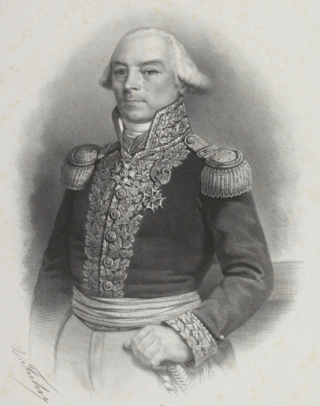
François Joseph Bouvet was a French admiral.

Charles-Alexandre Léon Durand, Comte de Linois was a French admiral who served in the French Navy during the reign of Napoleon Bonaparte. He commanded the combined Franco-Spanish fleet during the Algeciras Campaign in 1801, winning the First Battle of Algeciras before losing the Second Battle of Algeciras. He then led an unsuccessful campaign against British trade in the Indian Ocean and South China Sea in 1803, being defeated by a harmless fleet of the East India Company during the Battle of Pulo Aura and ending his cruise and sea-going career being bested in battle by John Warren in the action of 13 March 1806. Following the Bourbon restoration, Linois was appointed Governor of Guadeloupe. He supported Napoleon during the Hundred Days and so, on his return to France, he was forced to resign and was court martialled. Although acquitted, he was placed in retirement and never served again.

Vice-Admiral Count Pierre Étienne René Marie Dumanoir Le Pelley was a French Navy officer, best known for commanding the vanguard of the French fleet at the Battle of Trafalgar. His conduct during this battle was the subject of controversy.
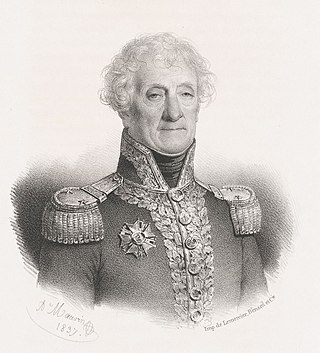
Baron Jacques Félix Emmanuel Hamelin was a rear admiral of the French navy and later a Baron. He commanded numerous naval expeditions and battles with the Royal Navy as well as exploratory voyages in the Indian Ocean and the South Seas.
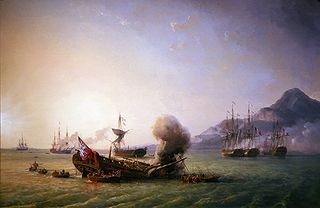
The Battle of Grand Port was a naval battle fought on 20–27 August 1810 between squadrons of frigates from the French Navy and the British Royal Navy over possession of the harbour of Grand Port on Île de France, as part of the Mauritius campaign during the Napoleonic Wars. A British squadron of four frigates sought to blockade the port to prevent its use by the French through the capture of the fortified Île de la Passe at its entrance. This position was seized by a British landing party on 13 August and, when a French squadron under Captain Guy-Victor Duperré approached the bay nine days later, the British commander, Captain Samuel Pym, decided to lure them into coastal waters where his forces could ambush them.
Admiral Sir William Beauchamp-Proctor, 3rd Baronet was an officer in the British Royal Navy, who served during the French Revolutionary and Napoleonic Wars.

Pierre Jean Van Stabel was a French naval officer and rear-admiral, famous for his role in the Glorious First of June.
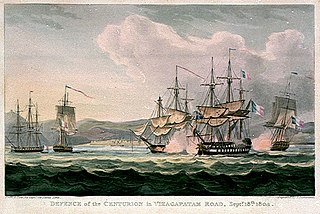
The Sémillante was a 32-gun frigate of the French Navy and the lead ship of her class. She was involved in a number of multi-vessel actions against the Royal Navy, particularly in the Indian Ocean. She captured a number of East Indiamen before she became so damaged that the French disarmed her and turned her into a merchant vessel. The British captured her and broke her up in 1809.

Carel Hendrik Ver Huell was a Dutch naval officer and statesman. He married Maria Johanna de Bruyn on 22 February 1789 at Hummelo, and had three sons with her.

Admiral Pierre-Louis-Charles Rigault de Genouilly was a French naval officer. He fought with distinction in the Crimean War and the Second Opium War, but is chiefly remembered today for his command of French and Spanish forces during the opening phase of the Cochinchina campaign (1858–62), which inaugurated the French conquest of Vietnam.

The Mauritius campaign of 1809–1811 was a series of amphibious operations and naval actions fought to determine possession of the French Indian Ocean territories of Isle de France and Île Bonaparte during the Napoleonic Wars. The campaign lasted from the spring of 1809 until the spring of 1811, and saw both the Royal Navy and the French Navy deploy substantial frigate squadrons with the intention of disrupting or protecting trade from British India. In a war in which the Royal Navy was almost universally dominant at sea, the campaign is especially notable for the local superiority enjoyed by the French Navy in the autumn of 1810 following the British disaster at the Battle of Grand Port, the most significant defeat for the Royal Navy in the entire conflict. After their victory, the British used the original Dutch name of Mauritius for Isle de France. In 1814, Île Bonaparte was returned to France, who eventually renamed it La Réunion.
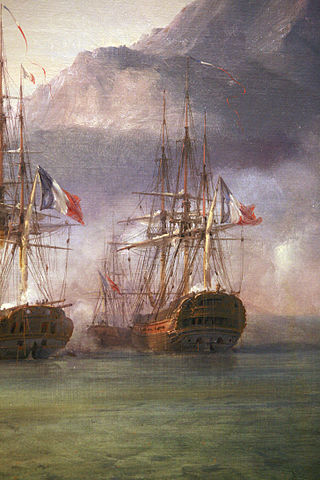
Revenant was a 20-gun privateer corvette, launched in 1807, and designed by Robert Surcouf for commerce raiding. The French Navy later requisitioned her and renamed her Iéna, after Napoleon's then-recent victory at the Battle of Jena–Auerstedt. The British captured her in 1808 and she served in the Royal Navy as HMS Victor. The French Navy recaptured her in 1809, taking her back into service under the new name. The British again captured her when they took Isle de France in December 1810. They did not restore her to service, and she was subsequently broken up.

Pierre-François-Henri-Étienne Bouvet de Maisonneuve was a French Navy officer and privateer.

The French frigate Minerve was originally launched in 1788 for the Portuguese Navy, where she served under the dual names of Nossa Senhora da Vitória and Minerva. The French Navy captured and renamed her in November 1809, after which she played a notable role in the Indian Ocean campaign of 1809-1811, participating in the defeat of a Royal Navy frigate squadron at the Battle of Grand Port, but at the surrender of Mauritius in December 1810, the ship was handed over to the British, and seems to have been broken up soon afterwards.

Linois's expedition to the Indian Ocean was a commerce raiding operation launched by the French Navy during the Napoleonic Wars. Contre-Admiral Charles-Alexandre Durand Linois was ordered to the Indian Ocean in his flagship Marengo in March 1803 accompanied by a squadron of three frigates, shortly before the end of the Peace of Amiens. When war between Britain and France broke out in September 1803, Marengo was at Pondicherry with the frigates, but escaped a British squadron sent to intercept it and reached Isle de France. The large distances between naval bases in the Indian Ocean and the limited resources available to the British commanders in the region made it difficult to concentrate sufficient forces to combat a squadron of this size, and Linois was subsequently able to sustain his campaign for three years. From Isle de France, Linois and his frigates began a series of attacks on British commerce across the Eastern Indian Ocean, specifically targeting the large convoys of East Indiamen that were vital to the maintenance of trade within the British Empire and to the British economy. Although he had a number of successes against individual merchant ships and the small British trading post of Bencoolen, the first military test of Linois squadron came at the Battle of Pulo Aura on 15 February 1804. Linois attacked the undefended British China Fleet, consisting of 16 valuable East Indiamen and 14 other vessels, but failed to press his military superiority and withdrew without capturing a single ship.
Vice-Admiral Robert Plampin was a British Royal Navy officer during the late 18th and early 19th centuries, serving in the American Revolutionary War, the French Revolutionary Wars and the Napoleonic Wars, but best known for his time as commander of the British colony of Saint Helena in the South Atlantic during the period when former Emperor Napoleon Bonaparte was imprisoned there. Born into a Navy family, Plampin went to sea at age 13 and fought throughout the American Revolutionary War, based principally in the Caribbean Sea. During the French Revolutionary Wars, Plampin served in a number of ships with mixed success, once being involved in a shipwreck and twice serving ashore during sieges. After the Peace of Amiens, Plampin took command of the ship of the line HMS Powerful and operated successfully in the Atlantic and the Indian Ocean. In 1816, following the defeat and capture of the French Emperor, Plampin was placed in command of the squadron at the Cape of Good Hope, which also had responsibility for Saint Helena, which Plampin regularly visited and had numerous conversations with Napoleon.
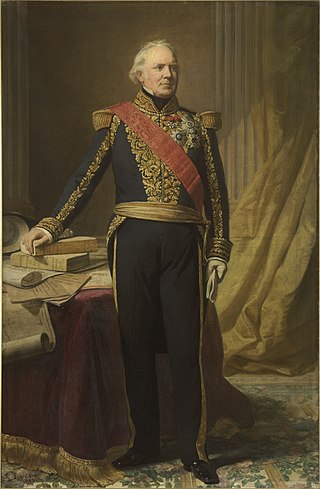
Ange René Armand, Baron de Mackau was a French naval officer and politician. In 1825, he led 14 brigs of war to Haiti in one of the earliest instances of gunboat diplomacy, forcing the recently emancipated people of Haiti to pay 150 million francs to their former enslavers. The Mackau Law that he later instigated as Minister of the Navy and of Colonies paved the way for the abolition of slavery.

Charles Pénaud was a French naval officer who rose to the rank of vice-admiral. As a young officer he was a member of the voyage of exploration and circumnavigation of Hyacinthe de Bougainville in 1824–26. In 1831 he participated in the Battle of the Tagus. He commanded a corvette during the French blockade of the Río de la Plata in 1838–40. During the Crimean War he was second in command of the Baltic Squadron and engaged in the Battle of Bomarsund in 1854. The next year, as commander of the Baltic Squadron, he bombarded Sweaborg. After the return of peace he was a member of the Admiralty Council and then president of the Naval Council of Works. In this role he was responsible for successful trials of the new steam-powered armoured warships.
Antoine Marie François Montalan was a French Navy officer active during the French Revolutionary Wars and the Napoleonic wars.

Henri-Louis Manceron was a French naval officer.